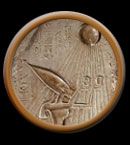|
|
- Ancient people and the Sun
- What happens when the Sun's lights goes out?
- Why is the Sun important to life on Earth?
- How long will the Sun last?
Although the Sun may be slightly dimmer or brighter, it's brightness is relatively
constant over our lifetimes. Instead, the Sun's light has been dimmed by shading
in the Earth's atmosphere now and then.
Volcanic eruptions tend to eject materials into the atmosphere that shade the surface from sunlight.
Asteroids, comets, and other bodies can collide with the Earth and eject shading
materials in to the Earth's atmosphere. Although difficult to document, one of the
best studied cases occurs at the Cretaceous-Tertiary boundary, 65 million years ago,
coincident with the extinction of many living things. This is often called the K-T event.
Earth scientists use the symbol K as shorthand for Cretaceous.
To think About:
???
To explore:
| |


